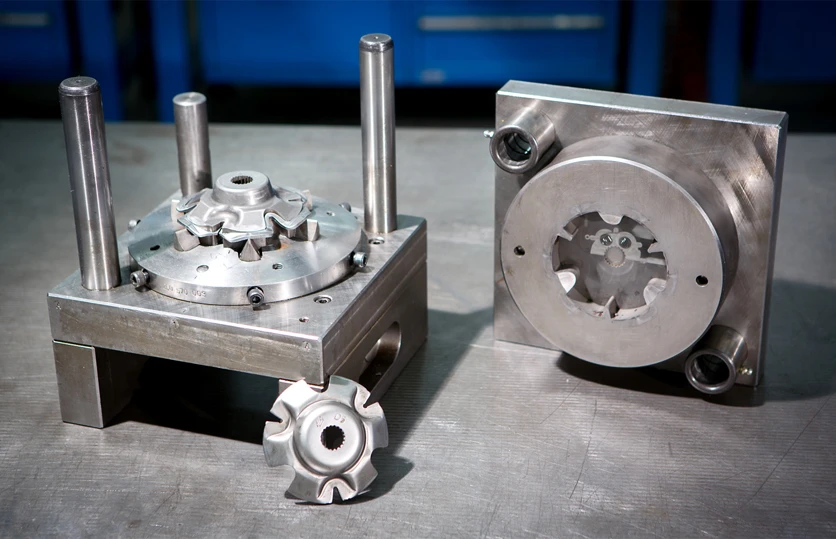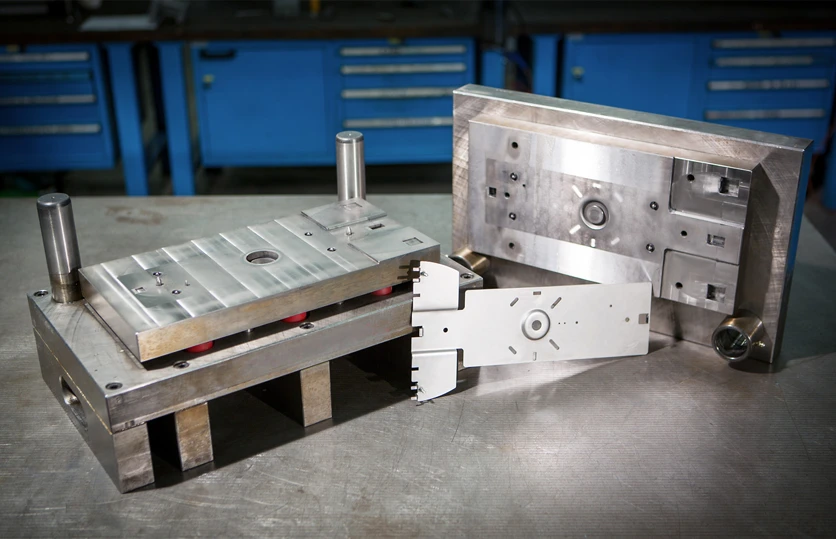
Types of moulds
Mevar designs and builds moulds for various types of sheet metal cold-processing such as deep drawing, curving, blanking and bending. We make individual moulds with one or more impressions, progressive moulds that combine several processes in the same mould and transfer moulds that make complex articles in optimized times. In addition to consulting, design and production, we ensure excellent maintenance after each production. We guarantee efficiency and high quality for each new order.

Moulds for deep-drawing and curvature
These moulds are used to produce a cold-formed article which has a concave or conical shape. The moulds are made up of punches and dies that bend the piece, straighten and compress the sheet.
Deep-drawing is used to produce deeper deformations on particularly ductile materials. Curvature is used to produce less deep deformation.
As an alternative to deep-drawing we can offer > Lathe Turning.
Deep-drawing is used to produce deeper deformations on particularly ductile materials. Curvature is used to produce less deep deformation.
As an alternative to deep-drawing we can offer > Lathe Turning.
Moulds for blanking
Moulds for blanking are used to cut and cold-deform any type of sheet metal: aluminium, iron, stainless steel, brass, copper or titanium. Thanks to a careful design, these moulds determine, with millesimal tolerance, the pre-established shape and characteristics of the item.
Blanking consists in cutting a sheet between two profiled cutters, punch and die, generating a fracture that reproduces the shape of the cutters themselves. Our moulds have been designed to ensure a product that fully meets expectations in terms of precision and resistance.
Blanking consists in cutting a sheet between two profiled cutters, punch and die, generating a fracture that reproduces the shape of the cutters themselves. Our moulds have been designed to ensure a product that fully meets expectations in terms of precision and resistance.


Moulds for bending
These moulds are usually commissioned to optimize production processes or simply because they are the only means to produce the required items.
When it comes to large batches, it is recommended to make the bending with a mould in order to guarantee precision and speed of execution, resulting in economic savings. This is possible because the moulds for bending allow you to make multiple folds, even complex ones, at the same time.
When it comes to large batches, it is recommended to make the bending with a mould in order to guarantee precision and speed of execution, resulting in economic savings. This is possible because the moulds for bending allow you to make multiple folds, even complex ones, at the same time.
Progressive moulds for combined machining
With a progressive mould it is possible to perform on sheet and/or tape different processes, combining them in several steps. In Mevar we can propose the realization of:
Technical Advantages
- Mould for blanking;
- Mould for blanking-bending;
- Mould for blanking-deep-drawing;
- Mould for blanking-bending and deep-drawing.
Technical Advantages
- Optimization of the production cycle: the progressive moulds for blanking are designed to produce one or more pieces simultaneously with each press stroke. This optimizes the efficiency and production speed.
- Large production volumes: they are ideal for the production of complex shapes and require high production volumes.
- Different processes: within the progressive mould, it is possible to carry out processes such as threading, coining, holes flaring, cutting, deep-drawing, curling and folding.
- High hourly production yield: thanks to the speed of the progressive mould, production is efficient and continuous.
- Low set up costs: installation on various similar presses is simple and set up costs are reduced.





